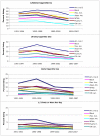Race/ethnicity, socioeconomic factors, and smoking among early adolescent girls in the United States
- PMID: 19628345
- PMCID: PMC2732752
- DOI: 10.1016/j.drugalcdep.2009.06.007
Race/ethnicity, socioeconomic factors, and smoking among early adolescent girls in the United States
Abstract
Background: This study uses large nationally representative samples of White, Black, Mexican American, Puerto Rican, Other Latina, Asian American, and American Indian 8th-grade girls to examine racial/ethnic differences and similarities in patterns, trends, and socioeconomic correlates of cigarette use.
Methods: The data are drawn from the University of Michigan's Monitoring the Future study. Prevalence and trend data (from 1991 to 2007) in girls' cigarette use were examined by racial/ethnic subgroup. Logistic regression analyses were conducted to determine the extent to which socioeconomic factors predict girls' cigarette use, and whether the relationships between socioeconomic status (SES) and smoking differed across racial/ethnic subgroup.
Results: Cigarette use was highest among American Indian girls; at an intermediate level among Mexican American, Puerto Rican, Other Latinas, and White girls; and lowest among Black and Asian American girls. Trend data show that cigarette use has declined for all racial/ethnic subgroups, and that small but consistent racial/ethnic differences in girls' cigarette use have persisted. Generally, girls who did not live in two-parent households, whose parents had lower levels of educational attainment, who attended lower SES schools, and who had more disposable income were more likely than their peers to smoke. That said, however, the relationships between smoking and parental education and school SES were, on average, stronger for White girls than for Black or Hispanic (Mexican American, Other Latina, Puerto Rican) girls.
Conclusions: Future research should seek to understand the mechanisms by which low SES impacts smoking.
Figures
Similar articles
-
Epidemiology of drug use among biracial/ethnic youth and young adults: results from a U.S. population-based survey.J Psychoactive Drugs. 2013 Apr-Jun;45(2):99-111. doi: 10.1080/02791072.2013.785804. J Psychoactive Drugs. 2013. PMID: 23908998 Free PMC article.
-
Racial/ethnic differences in the relationship between parental education and substance use among U.S. 8th-, 10th-, and 12th-grade students: findings from the Monitoring the Future project.J Stud Alcohol Drugs. 2011 Mar;72(2):279-85. doi: 10.15288/jsad.2011.72.279. J Stud Alcohol Drugs. 2011. PMID: 21388601 Free PMC article.
-
Can school income and racial/ethnic composition explain the racial/ethnic disparity in adolescent physical activity participation?Pediatrics. 2006 Jun;117(6):2158-66. doi: 10.1542/peds.2005-1920. Pediatrics. 2006. PMID: 16740860
-
Trends in Cigar Use in the United States, 2002-2016: Diverging Trends by Race/Ethnicity.Nicotine Tob Res. 2020 Apr 17;22(4):583-587. doi: 10.1093/ntr/ntz060. Nicotine Tob Res. 2020. PMID: 31013341 Free PMC article.
-
Differential Effects of Alcohol Policies Across Race/Ethnicity and Socioeconomic Status.Alcohol Res. 2025 Jan 14;45(1):02. doi: 10.35946/arcr.v45.1.02. eCollection 2025. Alcohol Res. 2025. PMID: 39830984 Free PMC article. Review.
Cited by
-
White and black adolescent females differ in profiles and longitudinal patterns of alcohol, cigarette, and marijuana use.Psychol Addict Behav. 2013 Dec;27(4):1110-21. doi: 10.1037/a0031173. Epub 2013 Feb 25. Psychol Addict Behav. 2013. PMID: 23438247 Free PMC article.
-
Social determinants of alcohol and cigarette use by race/ethnicity: Can we ignore measurement issues?Psychol Assess. 2020 Nov;32(11):1075-1086. doi: 10.1037/pas0000948. Epub 2020 Sep 14. Psychol Assess. 2020. PMID: 32924524 Free PMC article.
-
Self-reported use of novel psychoactive substances among attendees of electronic dance music venues.Am J Drug Alcohol Abuse. 2016 Nov;42(6):624-632. doi: 10.1080/00952990.2016.1181179. Epub 2016 Jun 17. Am J Drug Alcohol Abuse. 2016. PMID: 27315522 Free PMC article.
-
Reasons for recent marijuana use in relation to use of other illicit drugs among high school seniors in the United States.Am J Drug Alcohol Abuse. 2015;41(4):323-31. doi: 10.3109/00952990.2015.1045977. Epub 2015 Jun 26. Am J Drug Alcohol Abuse. 2015. PMID: 26115351 Free PMC article.
-
Minorities' Diminished Returns of Parental Educational Attainment on Adolescents' Social, Emotional, and Behavioral Problems.Children (Basel). 2020 May 18;7(5):49. doi: 10.3390/children7050049. Children (Basel). 2020. PMID: 32443584 Free PMC article.
References
-
- Adler E, Rehkopf DH. U.S. disparities in health: Descriptions, causes, and mechanisms. Annu Rev Public Health. 2008;29:235–252. - PubMed
-
- Bachman JG. Premature affluence: Do high school students earn too much? Econ Outlook USA. 1983;10:64–67.
-
- Bachman JG, O’Malley PM, Schulenberg JE, Johnston LD, Freedman-Doan P, Messersmith EE. The Education-Drug Use Connection: How Successes and Failures in School Relate to Adolescent Smoking, Drinking, Drug Use, and Delinquency. Lawrence Erlbaum Associates/Taylor & Francis; New York: 2008.
Publication types
MeSH terms
Grants and funding
LinkOut - more resources
Full Text Sources
Medical


